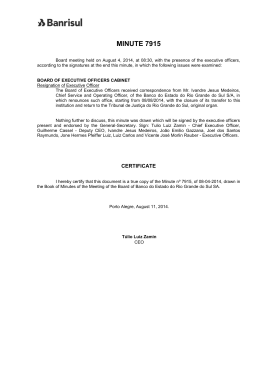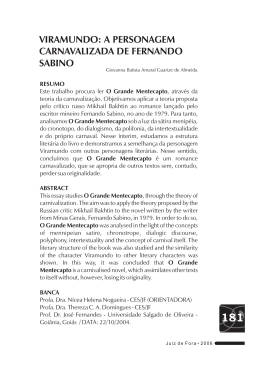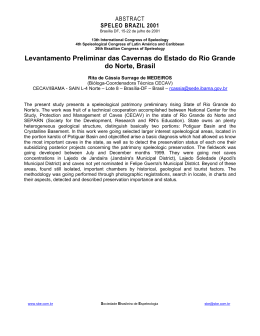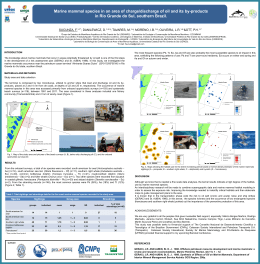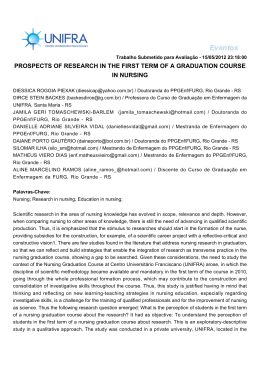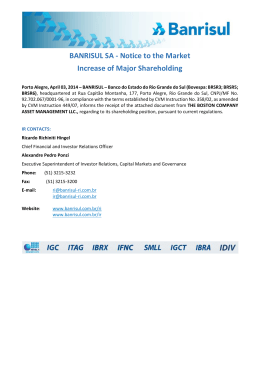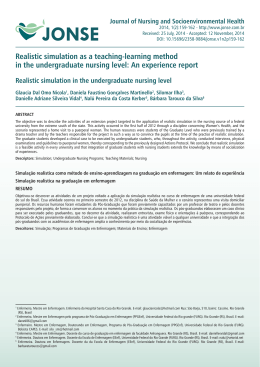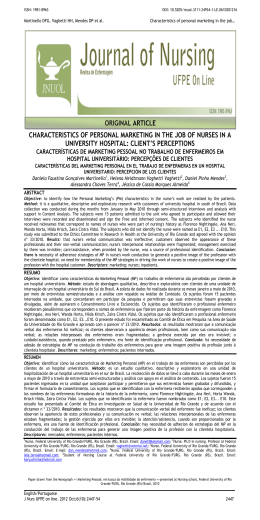Trabalho Submetido para Avaliação - 03/05/2012 00:03:03 THE CREATIVITY IN THE WORK OF NURSE: AN INTEGRATIVE REVIEW JESSICA DE CASSIA MARQUES DE ALMEIDA ([email protected]) / Enfermagem/Universidade Federal do Rio Grande, Rio Grande - RS DANIELA FAUSTINO MARTINELLO ([email protected]) / Enfermagem/Universidade Federal do Rio Grande, Rio Grande - RS DANIEL PINHO MENDES ([email protected]) / Enfermagem/Universidade Federal do Rio Grande, Rio Grande - RS ALESSANDRA CHAVES TERRA ([email protected]) / Enfermagem/Universidade Federal do Rio Grande, Rio Grande - RS SIMONE ZANOTTA FERREIRA ([email protected]) / Enfermagem/Universidade Federal do Rio Grande, Rio Grande - RS IVANETE DA SILVA SANTIAGO STREFLING ([email protected]) / Enfermagem/Universidade Federal do Rio Grande, Rio Grande - RS HELENA HEIDTMMAN VAGHETTI ([email protected]) / Enfermagem/Universidade Federal do Rio Grande, Rio Grande - RS Palavras-Chave: THE CREATIVITY IN THE WORK OF NURSE: AN INTEGRATIVE REVIEW Introduction: The creativity by the prospect of the labor force is immaterial, subjective and intangible. This is the generation of ideas, processes, products and/or new services that are capable of producing valuable benefits to the organization and/or for the well being of the people involved in the context. Already when considered as a process, creativity can be understood as the act of sharpen the perception of mishaps of the social surroundings simultaneously the survey of problems and difficulties.The creative act is an action inherent in every human being, and for this reason, must be treated as an object attached to him, instead of isolated. Thus, it is possible to perceive that the creativity of the nurse is in its condition as individuals and as something that when stimulated contributes to the profession. This element involves in benefits in the daily life of each one helping, and may help in the resolution of problems of relations that can be found in professional life, for example.Objectives: To know and characterize the scientific production on Creativity in Nursing, present in national journals. Methodology: An integrative literature review was performed between the months of January and March 2012. This type of research seeking the understanding of a given phenomenon by means of summarization of previous studies that address the matter. In the achievement of this research were adopted the following steps: formulation of the problem, data collection, evaluation of data collected, analysis and interpretation of data and presentation of results. The selection of articles has occurred on the bases Latin American and Caribbean Literature in Health Sciences (LILACS) and Scientific Electronic Library Online (SciELO). The initial amount of 164 articles reduced to 8 by the application of the exclusion criteria, which were: publications prior to 2007, construct in a foreign language, repetition in databases and inadequacy to the objective. The collection has made possible the construction of some categories. Results: About the authors, 27 authors published the 8 articles. All articles have between 3 and 4 authors. With respect to the formation of these authors were found to be or nursing students or nurses, and of these, 59.2 % were doctors. In the institutions of origin, 62.5 % were from the southeast region, 25% of the south region and 12.5 % of the region center west and northeast. As for the magazines, seven magazines published the 8 articles on the topic. Five are located in the southeast region, a region in central-west and one in the southern region. As to the Qualis criteria for classification of journals the Capes (Staff of Top Level) it was found that a revised southerner and a of the center-west have evaluation A2. Among the other, from the southeast, are stratified two as b1, two as A1 and a as b4. As for the focus, three articles showed progress in practice in mental health, referring to the creativity of nurses to deviate from the prescriptive model. Three articles reported the importance of health education as one of the functions of most relevance to nurse, and is an essential tool for creative thinking. A study shows that the adaptation and the improvisation of materials and equipment is a positive factor, since it ensures the continuity of care in a context of job insecurity, but that this can increase the risk of accidents at work. Finally, an article correlates creativity and light technologies used by nurses in their routine work. Conclusions: The authorship of articles follows the trend of publication held by doctors, because they have the training and the habit of disclosing the scientific knowledge, in addition to follow the requirements for production of funding agencies. The classification of two of magazines as A1 in Capes Qualis indicates that these have broad national movement that characterizes the association between Nursing and the relevant Creativity in scientific circles. The number of authors reduced in publications was a common phenomenon in nursing who loses the expressiveness, as the current trend and the articulation and collaboration among researchers. It was observed that the origin of the majority of the authors of the articles is southeast region, a fact justified by the increased concentration of undergraduate and graduate courses in Nursing in this region. The majority of the articles analyzed shows that nurses use their potential for creativity, mainly, in communication and reception. However, often these elements are not valued in your daily for being more exalted tangible elements such as equipment and materials. Due to the initial number of findings, it was evident that there are several studies that mention the creativity in the nurses' work in an informal way, but there is a lack of publications that address the creativity in all its depth. REFERÊNCIAS: Karl Marx; O capital: Crítica da Economia Política; São Paulo; Abril Cultural; 1983a. Cooper HM; The integrative research review: a systematic approach; Beverly Hills; Sage; 1984 . Torrance EP.Tradução de A. Arruda; Criatividade: Medidas, Testes e Avaliações. ; São Paulo; IBRASA; 1976. Lubart T. Tradução de Márcia Conceição Machado Moraes; Psicologia da Criatividade; Porto Alegre; Artmed; 2007. BRASIL; Coordenação de Aperfeiçoamento de Pessoal de Nível Superior (CAPES); http://www.capes.gov.br; abril - 2012.
Download


